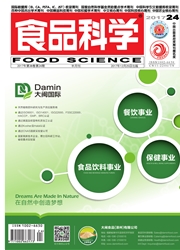

 中文摘要:
中文摘要:
采用电子鼻技术和固相微萃取结合气相色谱-质谱联用技术研究急杀致死、去鳃致死、低温致死和空气窒息致死等对草鱼肉挥发性成分的影响,同时研究了不同致死方式对草鱼肉中脂肪氧合酶活性的影响。其中急杀致死草鱼红肉中脂肪氧合酶(lipoxygenase,LOX)的活性最高为4 500 U/mL。通过电子鼻检测分析,4种致死方式条件下草鱼红肉可以区分,但腹肉和背肉不能区分。固相微萃取技术可以有效地吸附草鱼肉中的挥发性成分,急杀致死红肉、背肉和腹肉中分别确定出31、18 种和31 种挥发性成分,羰基化合物和醇类相对含量分别达到65.31%、76.22%和65.21%;去鳃致死红肉、背肉和腹肉中分别确定出27、27种和32种挥发性成分,羰基化合物和醇类相对含量分别达到65.00%、79.32%和90.30%;低温致死红肉、背肉和腹肉中分别确定出34、29种和29种挥发性成分羰基化合物和醇类的相对含量分别达到70.09%、70.53%和69.24%;空气窒息致死红肉、背肉和腹肉中分别确定出27、20种和20种挥发性成分,羰基化合物和醇类的相对含量分别达到78.04%、75.99%和71.27%。不同致死方式对草鱼鱼肉中LOX活性和挥发性成分有显著影响。
 英文摘要:
英文摘要:
The effect of different slaughter methods, i.e., knocking on head, gill removal, cryogenic temperature death and asphyxial death, on the volatile components of grass carp meat was investigated by using electronic nose and solid phase micro-extraction(SPME) combined with gas chromatography-mass spectrometry(GC-MS), as well as the effect on its lipoxygenase(LOX) activity. The maximal LOX activity of 4 500 U/mL was detected in crude enzyme solution from the meat of grass carp killed by knocking on its head. The electronic nose could distinguish the red meat rather than belly and back meat of grass carps killed by four different methods. SPME was able to effectively adsorb volatile components in grass carp. A total of 31, 18 and 31 volatile components were detected in the red, back and belly meat of grass carp killed by the first method, with carbonyl and alcohol compounds accounting for 65.31%, 76.22% and 65.21% of the total volatiles, respectively. A total of 27, 27 and 32 volatile components were identified in the red, back and belly meat of grass carp killed by the second method, with carbonyl and alcohol compounds representing 65.00%, 79.32% and 90.30% of the total volatiles. A total of 34, 29 and 29 volatile components were found in the red, back and belly meat of grass carp killed by the third method, with carbonyl and alcohol compounds comprising 70.09%, 70.53% and 69.24% of the total volatiles, respectively. A total of 27, 20 and 20 volatile components were found in the red, back and belly meat of grass carp killed by the fourth method, with carbonyl and alcohol compounds representing 78.04%, 75.99% and 71.27% of the total volatiles, respectively. To conclude, the different slaughter methods have significant effects on the activity of LOX and the volatile components of grass carp meat.
 同期刊论文项目
同期刊论文项目
 同项目期刊论文
同项目期刊论文
 期刊信息
期刊信息
